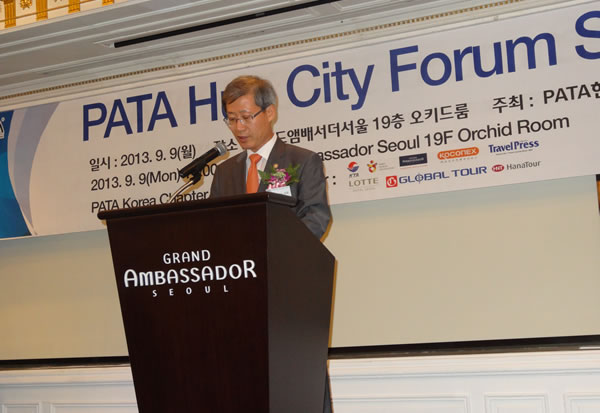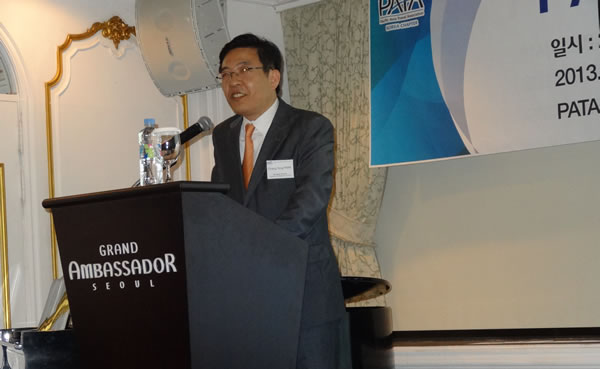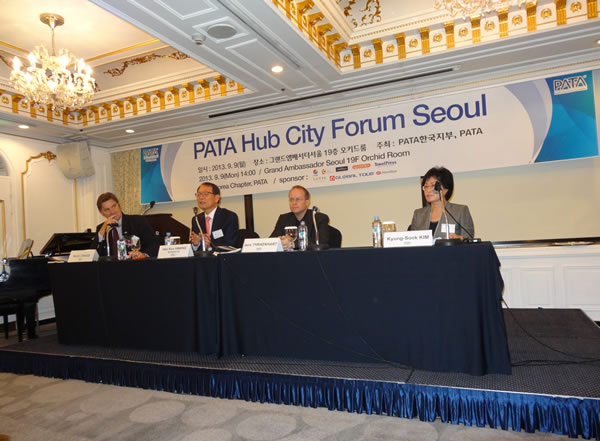 |
Speakers at the PATA Hub City Forum in Seoul, which focused on attracting the Chinese traveller and on the role of duty free in tourism |
SOUTH KOREA. The first PATA Hub City Forum, organised by Pacific Asia Travel Association (PATA), underlined the vital role of tourism for the South Korean economy, the importance of Chinese travellers to the country and the role that duty free plays in tourism infrastructure.
Speakers included Korea’s Vice Minister for Culture, Sports and Tourism Cho Hun-jae, senior figures from Korea’s tourism industry and from PATA and Lotte Duty Free Managing Director Business Development Division Chang Young Park. Among the invited international speakers was The Moodie Report Vice Chairman Dermot Davitt, who spoke on the role of travel retail in the tourism economy worldwide.
Korea Tourism Association Chairman Nam Sang Man noted that close to 11 million overseas tourists had visited Korea in 2012, with the government targeting 17 million by 2017 and 20 million in the years ahead. “What is important is that the tourism industry comes up with measures to respond to the growing Chinese tourism market, which is Korea’s largest.”
 |
Korea’s Vice Minister for Culture, Sports and Tourism Cho Hun-jae spoke about the tourism ambitions of government, and the role of public-private partnerships |
PATA CEO Martin Craigs noted that duty free was an often under-estimated part of the “complete visitor economy”. He said: “Tourism is a value chain; it’s about domestic and international travel, it’s about travel infrastructure and it’s about services.”
He forecast that Asia Pacific visitor arrivals would surge from 451 million in 2012 to almost 500 million in 2014, with Southeast Asia alone welcoming more than 80 million next year. By 2017 the region will see an estimated 581 million visitors. “We are in the world’s “˜sweet spot’ for tourism today.”
Chinese travellers will be a particular driver of tourism in Korea. PATA forecasts that 122 million will travel outbound by 2017 (from around 70 million today). “Even if half of those travellers continue to go to Hong Kong and Macau, it still leaves a vast audience for the rest of the region to attract,” noted Craigs.
 |
Chinese outbound travel growth will surge in the years ahead, PATA said |
Tourism Science Society of Korea President Kung-Sook Kim noted that Chinese tourists spend an average US$2,154 in Korea, compared to US$1,530 from other foreigners. Among independent travellers this figure for Chinese reaches US$2,318 compared to US$1,023 among Japanese visitors. She said that shopping and duty free in particular were key drivers of that spend among Chinese.
But she also noted some challenges for the Korean tourism industry in improving service to Chinese.
The language barrier was cited by Chinese (in a Korean Ministry of Culture, Sports & Tourism report) as the major complaint among Chinese travellers (45.2%) while other problems included high prices (cited by 18.9% of Chinese), food (14.8%) and lack of adequate signage and information that they could understand (10.2%).
Ms Kim noted the importance of a meeting held in July, hosted by President Park Geun-hye, that drew up a strategy to develop tourism to Korea. As well as hitting the 16 million visitor target by 2017, the government aims to grow tourism-related earnings to hit US$24 billion, up from US$14 billion in 2012.
The government is liberalising visa requirements for incoming Chinese, issuing double visas to residents of Beijing and Shanghai as well as university students, to encourage repeat visits, and avoid Chinese having to re-apply for visitor visas. South-east Asian nationalities will also receive double visas.
Other tourism-related initiatives include a plan to repay VAT on hotel room charges to overseas visitors from next year – aimed principally at Japanese travellers. The government also plans to expand the number of cruise ship berths available countrywide, and better regulate the industry to maintain high standards of service.
 |
Lotte Duty Free Managing Director Business Development Division Chang Young Park: duty free contributes hugely to the country’s tourism infrastructure |
 |
Lotte cited The Moodie Report Top 25 Travel Retailers list for 2012 – with Lotte in the top five |
Role of duty free
Lotte Duty Free’s Chang Young Park explained the vital role of duty free in the tourism economy, with retailers’ link to travel agencies plus the fact that 66% of overseas visitors come to Korea for shopping.
Of total tourism shopping in the country, he noted, 19.3% is at the airport with 27% downtown.
“We as duty free retailers have advantages such as the specialisation in the treatment of brands, our ability to manage brand inventories, customising the environment to match customer needs plus IT advances to help us achieve this, as well as build our CRM and loyalty programmes. Today, as a result of [the IT developments], some 10% of our sales are online.”
Park also cited duty free’s contribution to Incheon International, with W612 billion (US$565 million) in fees paid to the airport in 2012, or 31.5% of sales.
He also referred to Lotte’s expansion plans overseas. “We have moved into Guam and Jakarta airports recently. With this aggressive approach and further expansion, we can reduce operating costs across the business and increase competitiveness.”
Dragon Trail Co-Founder & President Jens Thraenhart addressed the social media component of Asian travel and tourism, notably in China. “Currently 8% of the world’s online population lives in China. By 2015 that will be 20%,” he said. He also said that from a figure of 1 billion mobile phone users and 400 million mobile Internet users today, there would be 1.3 billion mobile phone users and 1 billion mobile Internet users in China by 2015, underscoring the importance of a mobile e-commerce strategy for players in the tourism industry.
Outlet mall operator Value Retail Head of Tourism Ian Stazicker also spoke about the expansion of his company’s business from Europe to China. In 2014 the company will open its first Chic Outlet Shopping village in Suzhou Province near Shanghai, as part of a drive to attract Chinese consumers close to home.
At its European operations, sales to long-haul non-EU customers has surged from €40 million in 2007 to €425 million a year today. The key to this business is maximising the spend of the long-haul traveller, he noted.
 |
A special panel on China discussed the challenges of that market for Korean tourism |




